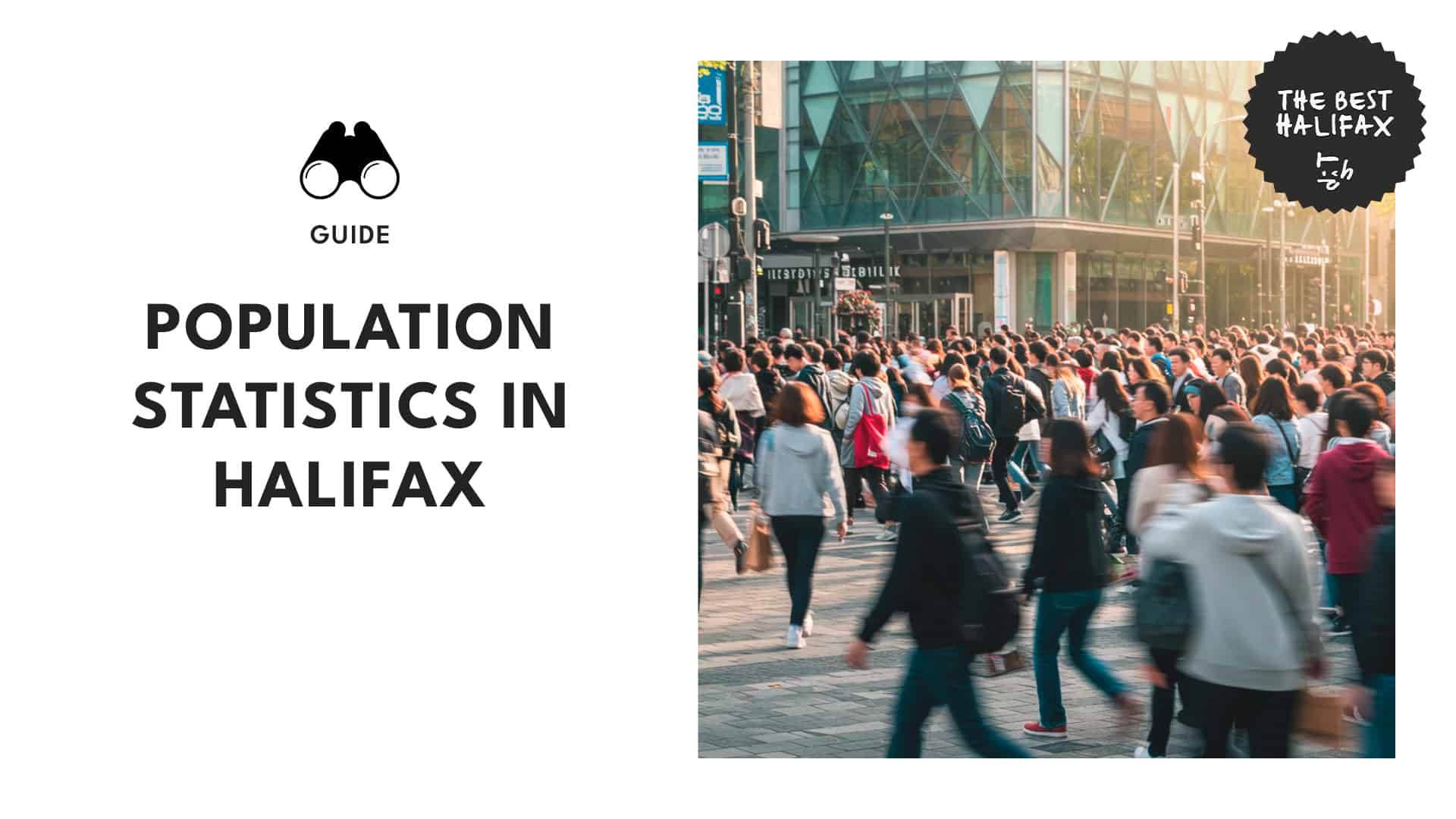Key Insights
| As per the Halifax Index 2024, Halifax is one of Canada’s most rapidly growing cities, with a population of 492,199 in 2023. Information from the Canadian Census shows that Halifax ranked 13th on the list of Canadian Urban Centers with the highest population. Based on a report by the World Population Review, Halifax has a median age of 40.4 years and an average age of 41.3 years. The same report reveals that the majority ethnic groups in the city are Canadian at 38%, English at 34%, Scottish at 30%, and Irish at 25%. GeoNova shows that Halifax’s aging population provides economic hurdles, with 17% of residents aged 65 and above. |
According to data from the Halifax Index 2024, Halifax has become one of Canada’s fastest-growing cities, with a population of 492,199 as of July 1, 2023.
This is an increase of 19,237 individuals, a 4.1% increase from 2022, which is also the largest single-year increase in the city’s history.
International migration was the main driver of the growth, adding almost 15,776 new residents, representing 80% of the increase.
Interprovincial movement also contributed, with 3,300 individuals, representing 17% of the overall growth, but at a reduced pace compared to earlier years.
In addition to its growing population, Halifax is experiencing demographic changes. For example, the median age dropped to 39.0 years, the lowest since 2009, indicating a younger population.
Meanwhile, the proportion of residents aged 65 and older hit a record high of 17.0%, pointing to an aging segment that continues to grow.
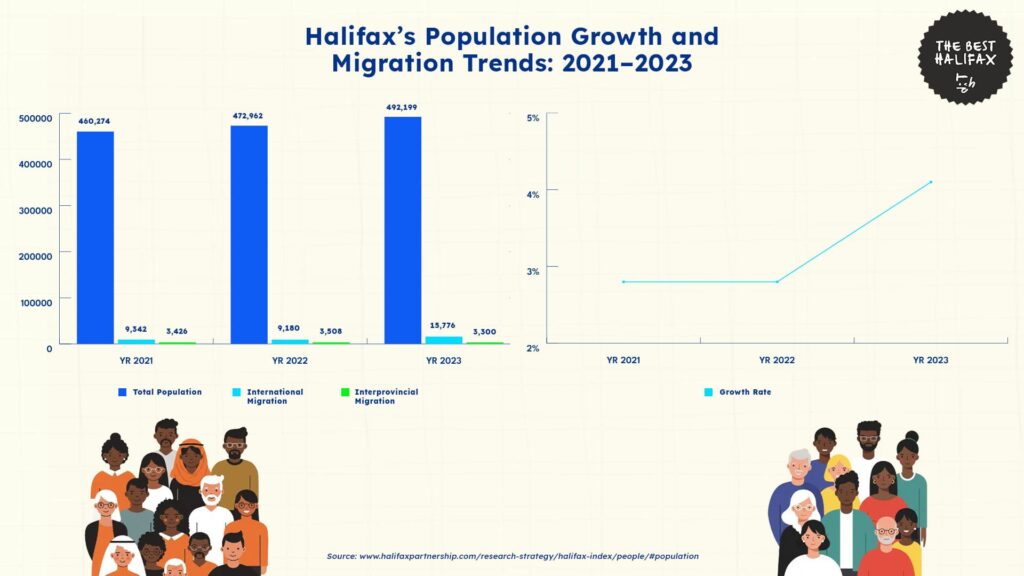
From 2022 to 2023, Halifax saw its highest annual population growth ever recorded, as the growth picked up significantly from 12,688 individuals in 2022, a 2.8% increase, to 19,237 individuals in 2023, a 4.1% rise.
Overseas migration continued to be the leading force, accounting for 15,776 newcomers, or a 72% hike from 9,180 newcomers in 2022.
Interprovincial migration, however, declined, with 3,300 individuals moving to Halifax from elsewhere in Canada, a 6% drop from 3,508 the year before.
Analysis of the Largest Population Centers in Canada
Data from the Canadian Census shows that Halifax ranked 13th among Canadian urban centers in 2021, with a population of 348,634. This represented a growth of 9%, the fourth-highest increase among the top 15 cities in Canada.
Only Kitchener, London, and Oshawa recorded faster growth rates, with London leading at 10%.
In contrast, the larger urban centers such as Toronto, Montreal, and Vancouver still maintained the largest overall populations, although their growth rates were relatively lower.
Meanwhile, Vancouver grew 6.9%, Montreal 4.2%, and Toronto 3.9%. Halifax grew faster than all three at a percentage level.
Although smaller than the other metropolitan centres, Halifax is more densely populated than most medium-sized cities.
Its population density of 1,463.2 per square kilometre compares with Ottawa-Gatineau at 1,945.1, Edmonton at 1,836.2, and Winnipeg at 2,124.8, emphasizing Halifax’s urban concentration.
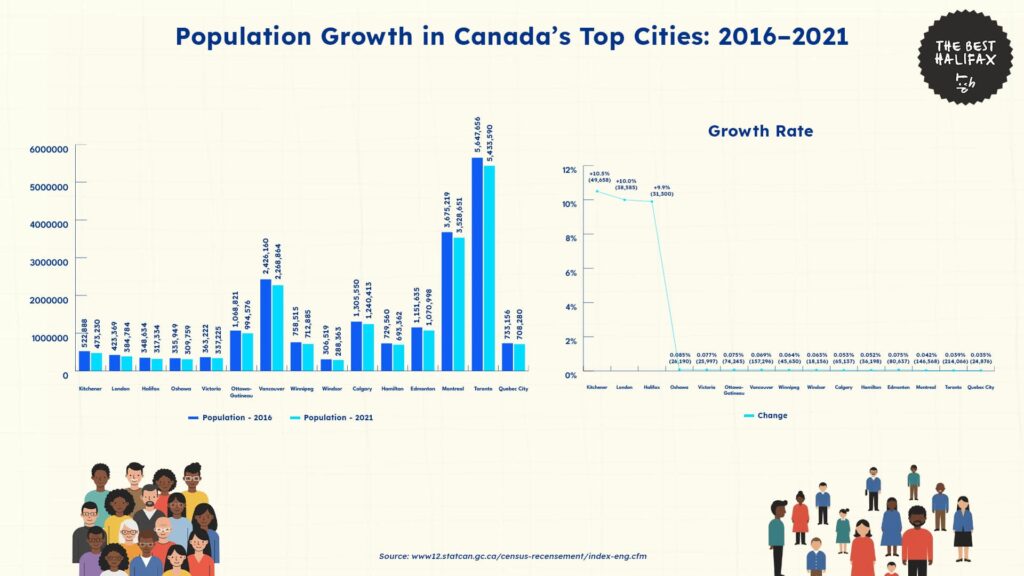
Age Distribution in Halifax
According to a report by the World Population Review, Halifax has a median age of 40.4 years and an average age of 41.3 years, reflecting a balanced mix of younger and older residents.
The city’s largest age group is 25 to 29 years, with 34,775 people, followed by 30 to 34 years at 33,180. These age groups represent a significant portion of Halifax’s workforce and suggest a strong presence of young professionals.
The 20 to 24 age group also remains substantial, with 32,125 people, likely driven by Halifax’s university presence.
The population gradually declines after age 35, but the 55 to 59 group sees an increase to 32,055 people, reflecting an aging workforce approaching retirement.
At the higher end of the age spectrum, Halifax has 8,565 people aged 80 to 84, 5,125 aged 85 to 89, and 2,065 who are aged 90 to 94. The city has 605 residents aged 95 to 99, showcasing a small but notable portion of the population reaching advanced ages.
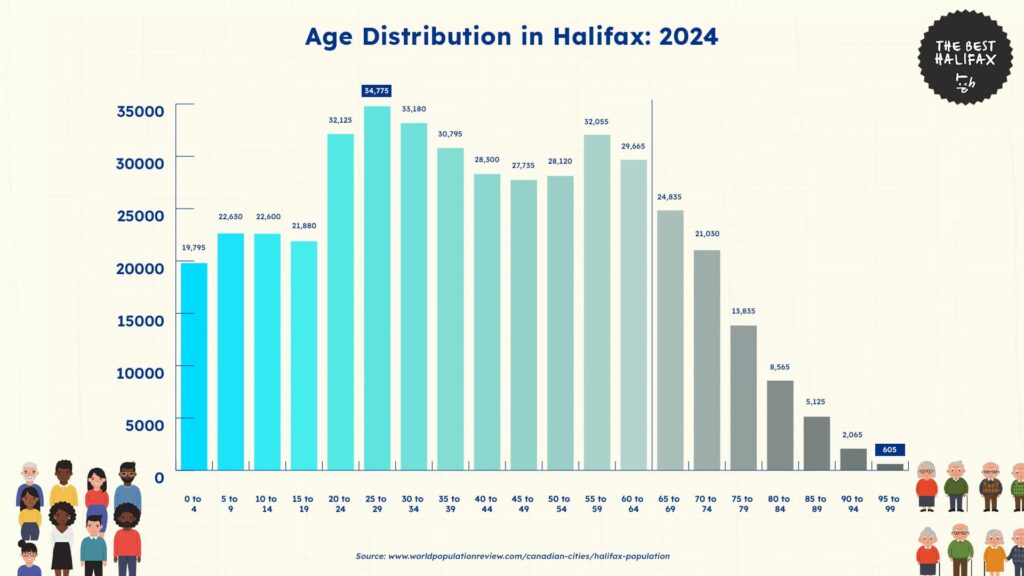
Demographic Breakdown
Ethnic Composition of the Population in Halifax
Halifax has a diverse population with a range of ethnic backgrounds. According to the World Population Review, the largest ethnic groups in the city include Canadian at 38%, English at 34%, Scottish at 30%, and Irish at 25%.
French ancestry accounts for 18% of the population, while German and Dutch origins make up 12% and 4%, respectively. Smaller ethnic groups include North American Indian at 3% and Welsh at 2%.
The city is also home to between 1,000 and 7,000 residents from other backgrounds, including Italian, Polish, Lebanese, Chinese, African, East Indian, American, Norwegian, Spanish, Jewish, and Greek communities.
This mix reflects Halifax’s long history as a settlement hub and its continued role as an economic and cultural center in Nova Scotia.
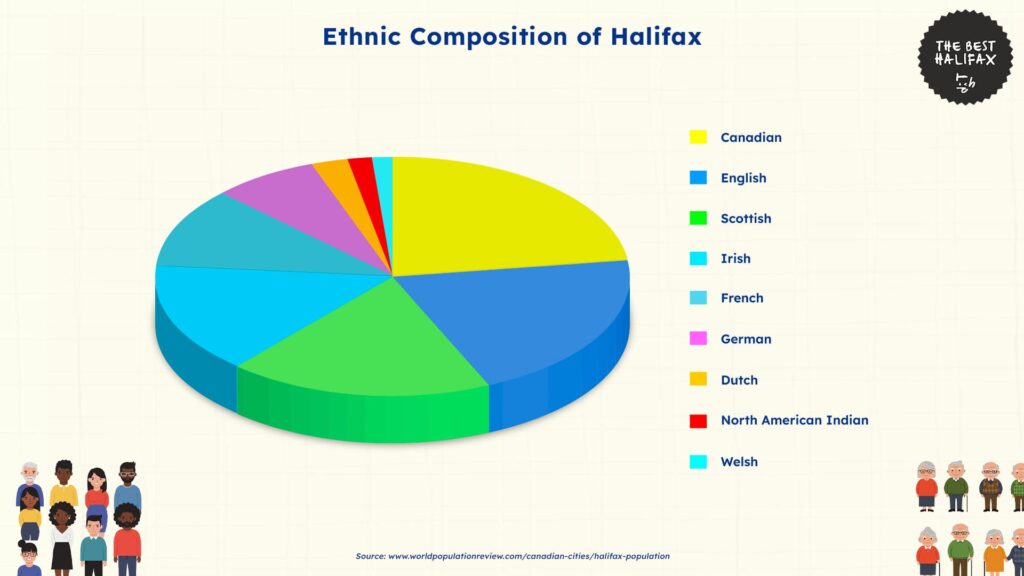
Religious Composition of the Population in Halifax
The same report shows that Christianity remains the dominant religion in Halifax, with 85% of the population identifying as Christian.
Those with no religious affiliation make up 13% of residents, indicating a growing secular segment.
Meanwhile, less than 1% of the population follows Islam, Judaism, Buddhism, Hinduism, or Sikhism, highlighting a smaller representation of non-Christian religious groups in the city.
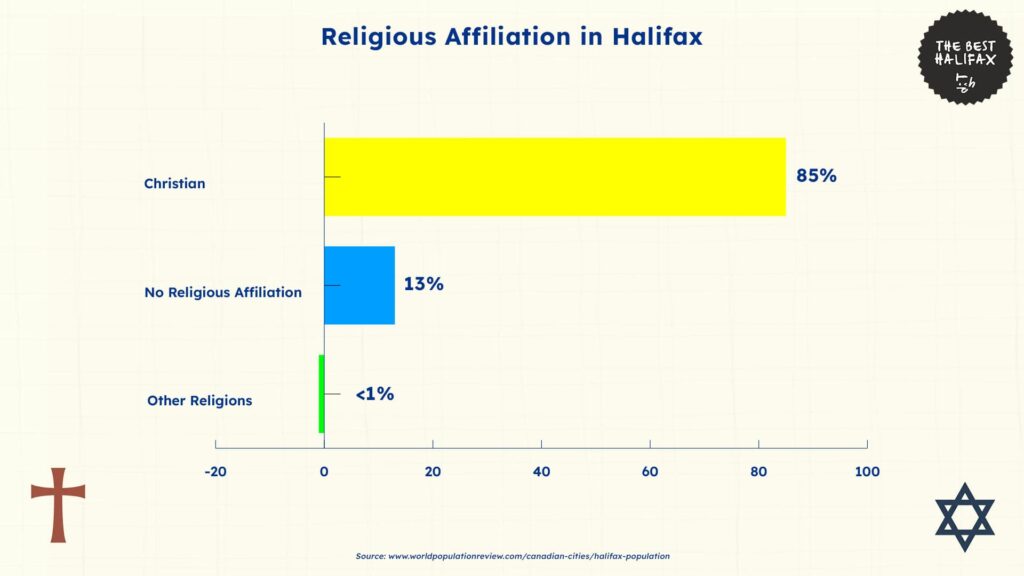
The Issue of Halifax’s Aging Population
Economic Challenges
Halifax’s growing older population creates substantial economic challenges, as detailed in a GeoNova report. With 17% of citizens aged 65 or older, its workforce dwindles as more workers retire.
Decreasing workforce levels can translate to shortages in core industries, a decrease in overall economic productivity, and putting heavier burdens on the younger population to continue to grow the economy.
The healthcare, service, and trades occupations are the most at risk for shortages in workers, potentially affecting service availability and economic stability.
Healthcare and Social Service Expenditures
With the increasing number of seniors, Halifax will see growing healthcare expenses. Seniors usually need more medical care, prolonged treatment of chronic diseases, and specialized geriatric services.
The province already has tension in its health care system, and an elderly population will create more hospital admissions, home care requirements, and occupancy in long-term care facilities.
Long-term care services become progressively expensive. As the senior population increases, more needs to be invested to increase senior housing, homecare programs, and long-term care facilities.
Without sufficient funding, wait times for medical care and assisted living facilities may increase, placing more stress on families and caregivers.
Burden on Public Pension and Social Programs
With more retirees, Halifax will experience added pressure on pension schemes and social services.
A reduced ratio of working-age citizens to retirees translates into fewer tax payments to support Canada’s public pension system, healthcare funding, and social programs.
Absent policy changes, the danger exists of funding deficits, lower benefits, or increased taxes on the working population to ensure fiscal stability.
Meanwhile, poverty among the elderly is a concern, especially for those who have little private savings.
Increased living expenses, particularly in health care and housing, could make some older adults financially at risk, necessitating increased government aid and senior-specific social support programs.
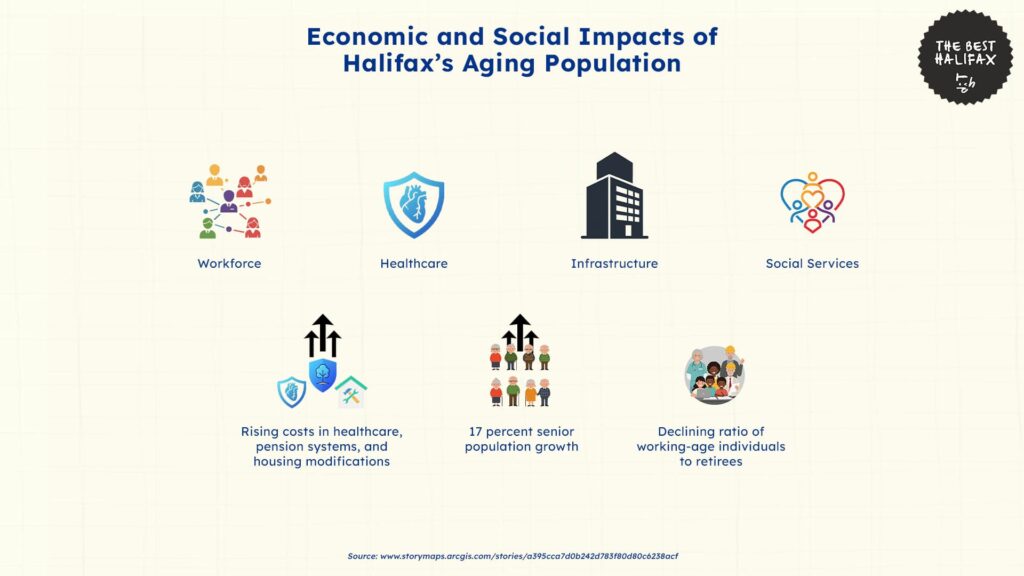
Interventions and Solutions to the Issue of Halifax’s Aging Population
The SHIFT: Nova Scotia’s Action Plan for an Aging Population identifies strategic responses to the issues presented by an increasing senior population.
The report shows that 25% of workers between the ages of 65 and 69 are still working, but many are deterred by rigid workplaces and inadequate retraining opportunities.
SHIFT encourages age-friendly workplace practices, flexible work schedules, and focused training programs to enable older workers to continue contributing to the labor force.
Volunteerism is also an important area of activity, with 44% of older Nova Scotians participating in community service.
The strategy promotes programs that allow for mentorship, leadership positions, and volunteerism, keeping seniors socially engaged and making valuable contributions to society.
Healthcare is also an important part of the action plan. This strategy gives priority to the growth of interprofessional healthcare teams, mental health services, and infrastructure renovations, such as the rebuilding of the QEII Health Sciences Centre.
Moreover, action plans like the Let’s Get Moving Action Plan promote active aging among older adults through exercise and improved diet, reducing the risk of chronic disease and mobility loss.
Another important strategy is to support seniors to age in place. The strategy invests in affordable and accessible housing options, such as home modification grants to enable older persons to stay in their homes securely.
Transport upgrades, especially in rural settings, provide for the accessibility of seniors to vital services and social events.
Interventions like the Seniors’ Safety Program and the Age-Friendly Grant Program aim to curb social isolation through increased community integration and stronger networks of support among older adults.
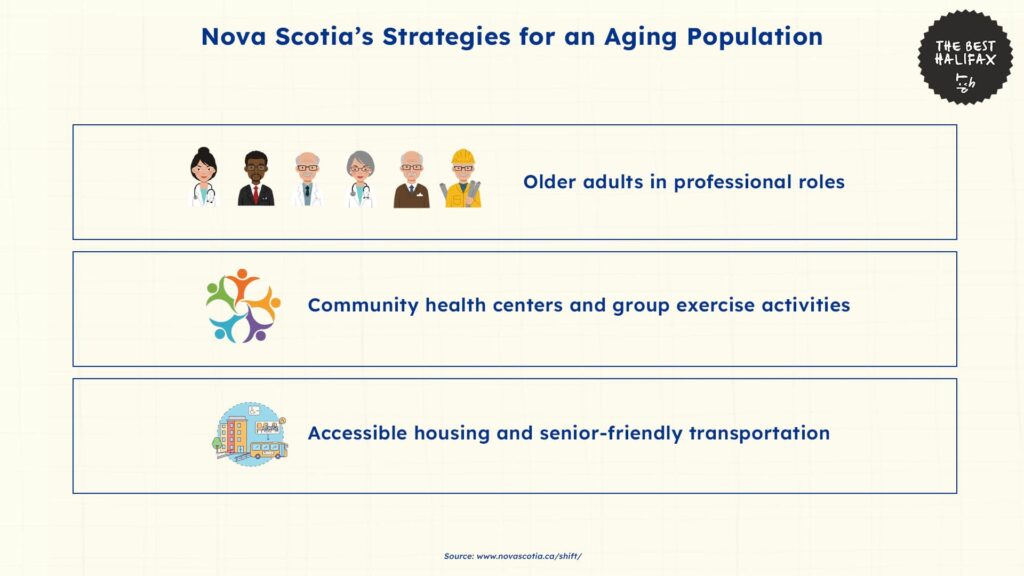
The Future for Halifax’s Growing Population
The Canada Population Census predicts that Halifax’s population is expected to keep expanding strongly, fueled mainly by overseas migration and continued economic prospects.
With a 4.1% population growth in 2023, the city is still among the most rapidly expanding urban areas in Canada. If this trend maintains itself, Halifax may reach a population of over 500,000 in a matter of years.
Most notably, Halifax will experience a further demographic change toward an aging populace. As of 2023, 17% of the population is 65 or older, and this percentage is likely to grow as life expectancy rises and births decline.
Despite these challenges, Halifax is positioned to capitalize on its increasing population for social and economic growth. The ongoing migration of immigrants and young professionals might help offset some of the economic threats of an aging population.
The strategic investment of the city in healthcare, housing, and infrastructure will play a crucial role in how it responds to these changes.
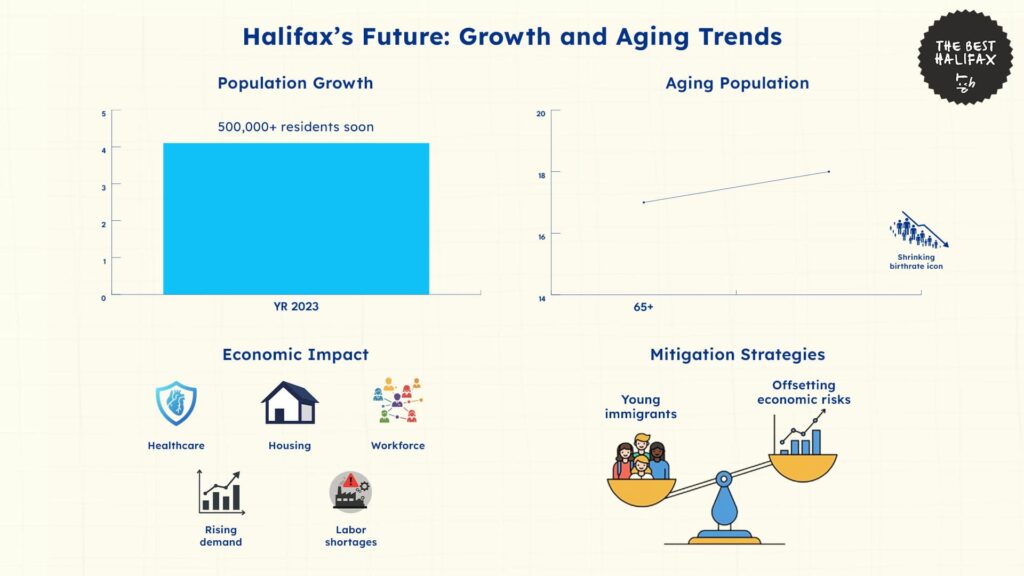
References
- Canada Revenue Agency. (n.d.). Medical expenses 2024. Government of Canada. Retrieved March 4, 2025, from https://www.canada.ca/en/revenue-agency/services/forms-publications/publications/rc4065/medical-expenses.html
- Government of Nova Scotia. (n.d.). Senior safety programs. Retrieved March 4, 2025, from https://novascotia.ca/seniors/senior_Safety_Programs.asp
- Government of Nova Scotia. (2017). SHIFT: Nova Scotia’s action plan for an aging population. Retrieved March 4, 2025, from https://novascotia.ca/shift/
- Halifax Partnership. (n.d.). Halifax index: People and population. Retrieved March 4, 2025, from https://halifaxpartnership.com/research-strategy/halifax-index/people/#population
- Statistics Canada. (n.d.). Census of population program. Government of Canada. Retrieved March 4, 2025, from https://www12.statcan.gc.ca/census-recensement/index-eng.cfm
- World Population Review. (2024). Halifax population 2024. Retrieved March 4, 2025, from https://worldpopulationreview.com/canadian-cities/halifax-population
- StoryMaps. (2024). Halifax demographic trends. Retrieved March 4, 2025, from https://storymaps.arcgis.com/stories/a395cca7d0b242d783f80d80c6238acf
